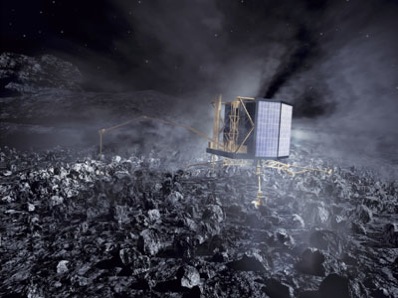
Rosetta swingby may help solve cosmic mystery
DR EMILY BALDWIN
ASTRONOMY NOW
Posted: November 12, 2009


Tomorrow ESA's comet chaser spacecraft Rosetta will swing by the Earth for a critical gravity assist, but mission controllers will also be looking out for a curious change in orbital speed that may help unravel a long-standing mystery.
For nearly thirty years mission controllers at ESA and NASA have noticed that their spacecraft sometimes experience a strange variation in the amount of energy they exchange with Earth as they flyby on gravity assist maneuvers, manifesting as minute differences in speed gained or lost compared with the amount predicted by the fundamental laws of physics.
 As Rosetta swings by the Earth tomorrow, missions controllers will be looking out for any unexpected changes in its speed. Image: ESA/C. Carreau. As Rosetta swings by the Earth tomorrow, missions controllers will be looking out for any unexpected changes in its speed. Image: ESA/C. Carreau.
The theory-defying spacecraft include NASA's Galileo mission to Jupiter, which experienced an increase of 3.9 millimetres per second when it swung by the Earth in December 1990, to a 13 millimetre per second boost experienced by NEAR in January 1998. On the other extreme, Cassini experienced a slowdown when it swung by the Earth in 1999. Curiously, other spacecraft have suffered insignificant variations.
Rosetta has already slingshotted around the Earth twice. In 2005 it sped up by 1.8 millimetres per second, but in 2007 showed no variation.
"It's a mystery as to what is happening with these gravity events," says Rosetta flight dynamic specialist Trevor Morley. Possible causes include tidal effects peculiar to the near-Earth environment, atmospheric drag, or the pressure of radiation emitted or reflected by the Earth. Extreme possibilities go so far to suggest that dark matter, dark energy or previously unseen variations in General Relativity may be to blame. A further exotic suggestion is that Earth's rotation is somehow distorting space-time more than expected, although there is no explanation of how this could happen.
 An artistŐs impression of the Philae lander at work on the nucleus of Comet 67P/Churyumov-Gerasimenko. While Rosetta studies the comet from close orbit, Philae will obtain measurements from the nucleus surface. Image: ESA/AOES Medialab. An artistŐs impression of the Philae lander at work on the nucleus of Comet 67P/Churyumov-Gerasimenko. While Rosetta studies the comet from close orbit, Philae will obtain measurements from the nucleus surface. Image: ESA/AOES Medialab.
Similarly, the Pioneer spacecraft have both experienced an unexpected acceleration directed toward the Sun as they travel on trajectories that will eventually take them into interstellar space.
Spacecraft speed errors, software bugs, calculation errors, tracking uncertainties and more, have all been eliminated.
As Rosetta closes in on the Earth on 13 November the mission control team will be watching closely. "We are using as many ground stations as are available to maximise the amount of swingby data we record, says Morely. "The more data we get, the better the chance that we may eventually come up with an answer. As it stands now, no one knows what's behind this - it really is a mystery."
Rosetta, comprising an orbiter and a lander, will be the first spacecraft to undertake long-term exploration of a comet. Launched in 2004, it will reach comet 67P/Churyumov-Gerasimenko in 2014, studying it for around two years as it careers towards the Sun.
|



